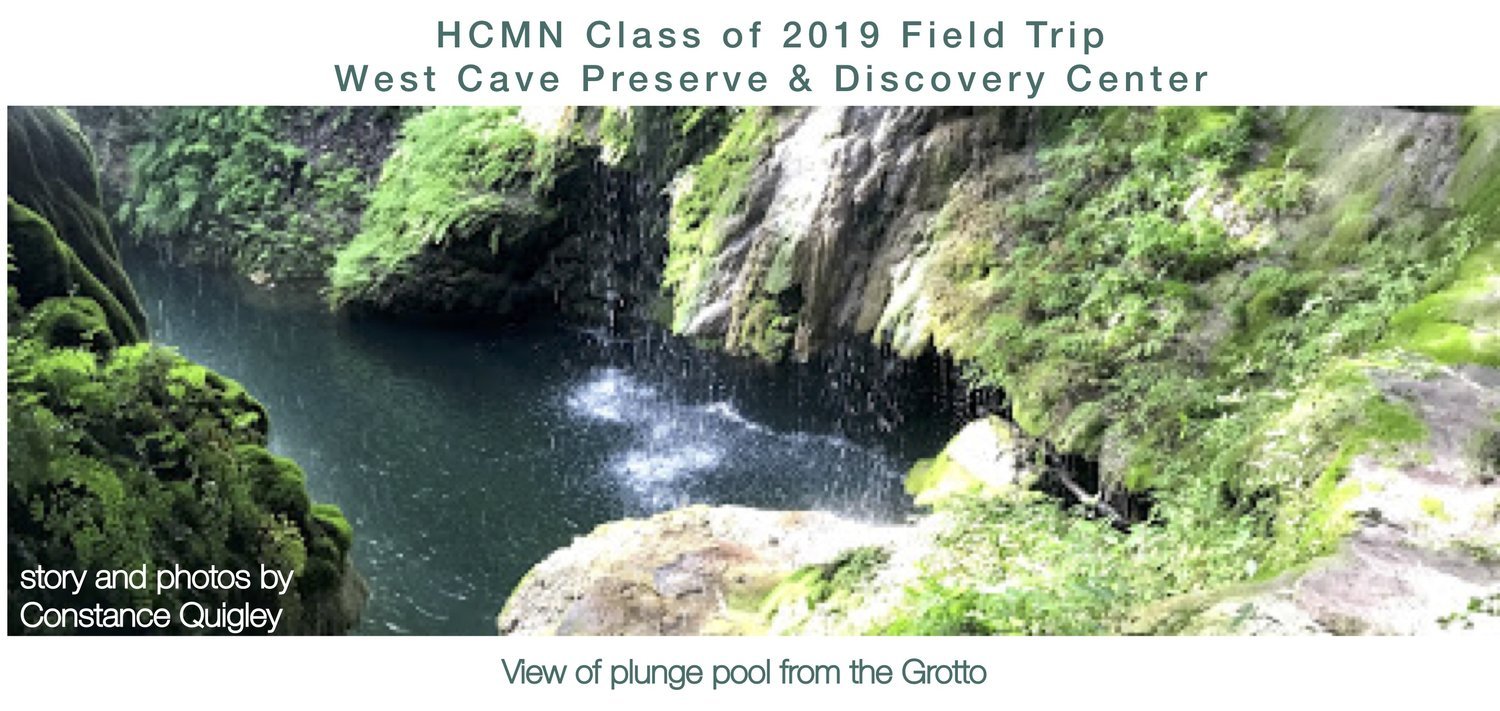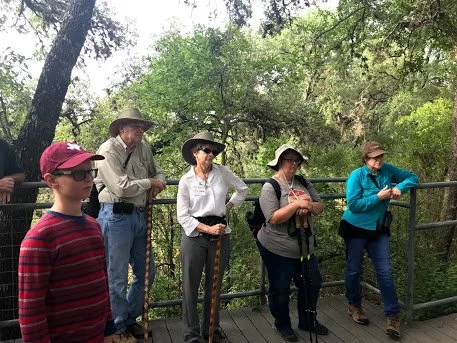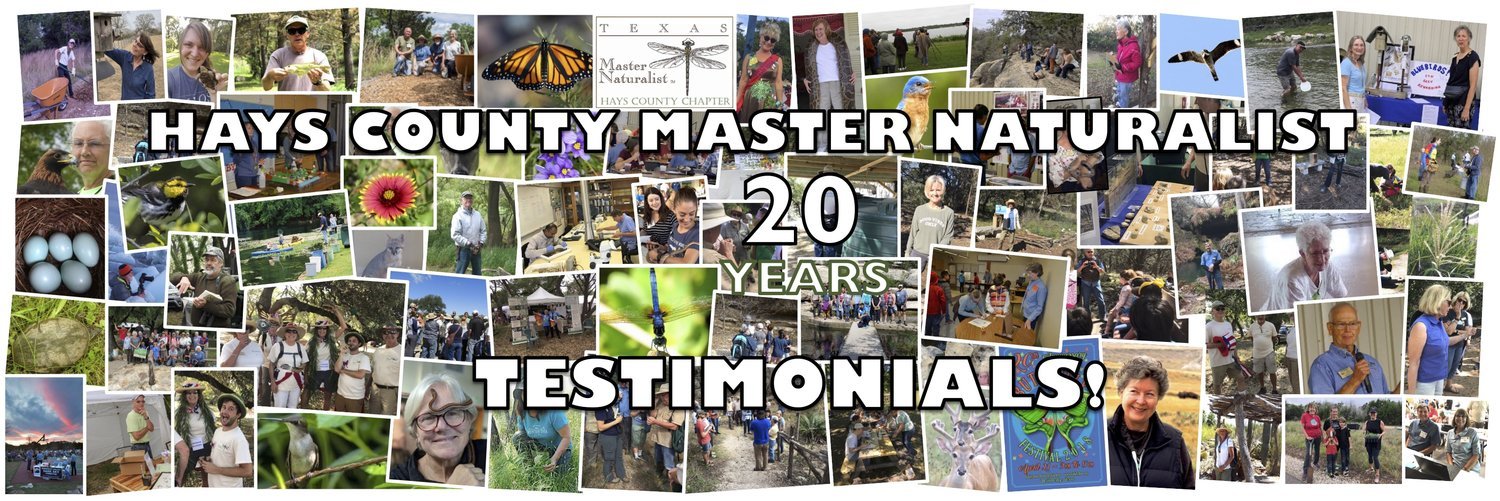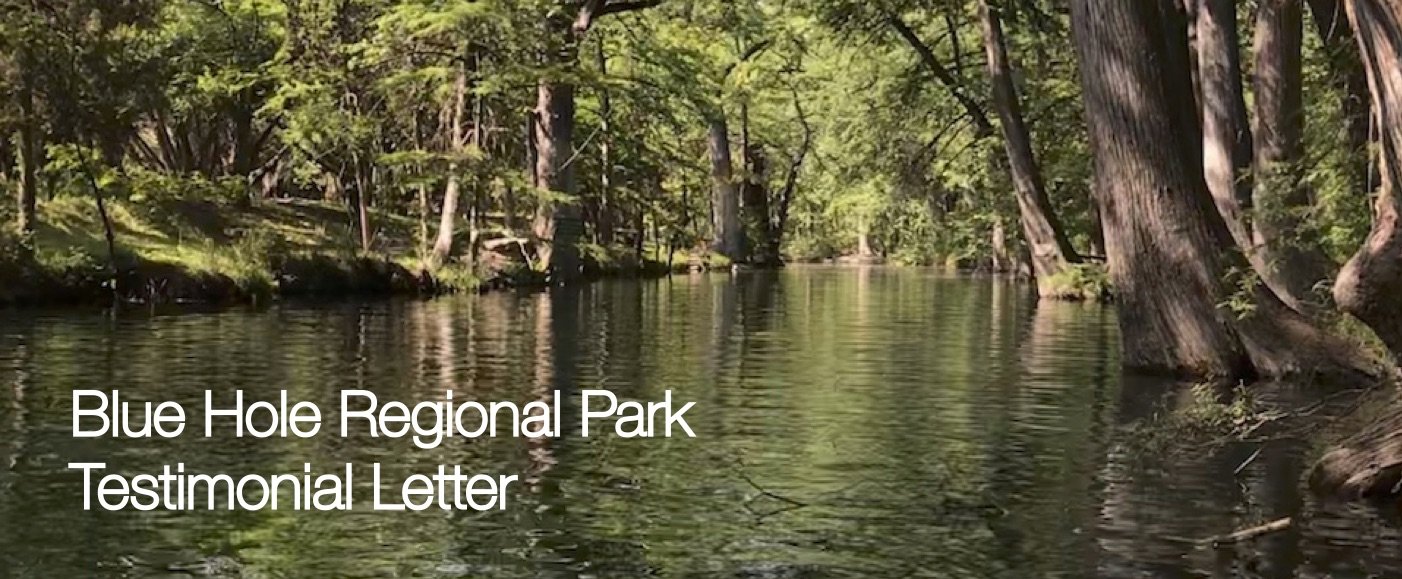The Hays Humm - July 2019
TOM JONES, BETSY CROSS, CONSTANCE QUIGLEY
Sarah Carlisle
About Me: I came to America from Britain in 1984 with my family. We moved to San Marcos sight-unseen. I am a pediatric nurse. As an RN, I worked at a newborn nursery and then in Early Childhood Intervention, a program designed for families of young children, birth to age 3, who have developmental delays, disabilities, or certain medical diagnoses that may impact their development. I did this “homespun care” for 17 years before retiring in 2007. Once retired, I went off to College Station for a week-long course to become TCEQ-certified and run the water system for our church. I also joined the Wimberley Herb Society and eventually discovered Master Naturalist. I am a graduate of the 2016 HCMN class, the Ravens. Now I live in Wimberley on my little piece of paradise with my beautiful labradoodle, Nutmeg. Last year I installed a 30,000-gallon rain water harvesting system. My home is on full rain water collection now.
(English) Robin
What You May Not Know: I love to go sailing. My brother had a 9-foot boat and when I was about 10 years old, I got my own boat. I was very good at sailing as a child and would sail in Chichester Harbour at every opportunity. I sailed there until 1959, when I went to Guy’s Hospital in London to do my nursing training.
Favorite MN Activity: I grew up on the water, and water conservation is deep in my veins. My work with the Texas Stream Team to monitor water on the Blanco is my favorite activity. I am very concerned about climate change, and if each person did one small thing each day to try and conserve and recycle, we could take it out of the hands of the politicians and do it ourselves. Let it begin with me!
Favorite Bird: The (English) Robin because it’s little, cheeky, and brave! If you are not familiar with this robin, here is a photo.
Sue Harding
About Me: Born and raised in Philadelphia, PA, I was a true city girl where playgrounds were of asphalt and concrete. With brief respites to local creeks, city parks, and the Jersey shore, the seed was planted for wanting more natural and green environs. Studying geology was my ticket out to the great outdoors and a brief career as an oil and gas geologist and later, community college teacher, living in six states and Australia along the way. Texas has been home for the last 21 years, Dripping Springs for the last 2+ years.
In 2018, I transferred my membership to HCMN from the Gulf Coast Chapter master naturalists, from which I graduated in 2012. I loved learning about the flora and fauna of the three ecosystems that intersect in the Houston area and ‘grew’ my passion for native plants at the Houston Arboretum and Nature Center. Although I made peace with the heat and humidity of the Bayou City, I’m thrilled now to be living the good life in the Texas hill country! Today I combine my love of native and well-adapted plants, the local ecosystems, and an eye for good design, as a freelance landscape designer.
What You May Not Know: I enjoyed playing many sports as a kid (softball, basketball, tennis), coached a middle school girls basketball team that won their town championship in Ventura, CA, and still love playing tennis today. I have tennis legend Arthur Ashe to thank, since I was able to take free tennis lessons as a kid and be part of the National Junior Tennis League from the program he started in 1968 which offered free lessons to inner city kids.
Favorite MN Activity: Charro Ranch Park is where I spend much of my volunteer hours as co-lead coordinator along with Tom Hausler. And I am still discovering other fun areas where I can be of service. Recently, I agreed to be the local HCMN outreach liaison for Dripping Springs, for which I am excited and looking forward to getting more of our new residents on board with our mission.
“If you want a good sermon, walk out into this country, that is where things come together.”
Gay Ruby Dahlstrom - Photo Ref: Buda Mill & Grain Co. blog.
Cecil and Louise Ruby began purchasing property along Onion Creek in 1932, and by 1936, the Ruby family, including their two children, were living on that property. The younger of the two children was Gay Ruby – she was 6 years old at the time. Her older brother Jim also lived there. By 1953, they had amassed a property of 4,900 acres known as the Cecil Ruby Ranch. The ranch was used for a livestock operation involving horses, cattle, sheep and goats. In 1959, Cecil began the process of installing a 9-foot game fence around 3,700 acres of the property. He then brought in herds of blackbuck antelope and axis deer to the fenced portion of the property. Exotic game hunting was a common operation for years. From 1972 to 1993, grazing rights were leased to the Y.O. Ranch who maintained a herd of about 100 longhorn cattle on the property. Cecil Ruby passed away in 1993, and the 4,900-acre ranch was split between Cecil’s two children, James Cecil Ruby, Jr. and Gay Ruby Dahlstrom. James Ruby’s section was eventually developed into the Ruby Ranch Subdivision.
In 2001, Gay had a vision of the future for her family’s land. She wanted to prevent the land from ever being divided or developed to preserve its beauty. Gay began to create a plan to preserve the ranch, while allowing her family to continue to own and manage the land. In 2007, talks began to negotiate a conservation easement / preservation agreement. In 2008, a conservation easement for the 2,254-acre Dahlstrom Ranch was executed between the Dahlstrom Family, Hays County, the City of Austin, and the Hill Country Conservancy.
As part of this agreement, a unique decision was made to create a nature preserve on a portion of the property that allowed for public access on private land. This 384-acre piece of land was once called the John Howe tract or Howe Pasture. This section was the last portion of land Cecil Ruby added to his ranch and is slightly larger than Zilker Park (350-acre). The Nature Preserve is now accepting reservations for hiking and guided tours.
The history summary is an excerpt from the Hays Country Parks Department interpretative guidebook.
Preserving open space in the Hill Country is vital to maintaining the quality and quantity of sustainable water resources.
Cripple Crawfish Cave in Onion Creek
A significant recharge feature is Cripple Crawfish Cave near the Dahlstrom Ranch. Onion Creek flows directly into the cave and the Edwards Aquifer. The rush of water into the cave creates a whirlpool in the Creek during high flow conditions. Ref. Austin Geological Society.
Undeveloped land in the Hill Country is vital for the protection of wildlife habitat, outdoor recreation, and spiritual renewal, but also critical to sustainable supplies of water. The abundance of karst terrain creates vast areas of porous limestone, which is the origin of the huge Edwards and Trinity (Cow Creek) aquifers. These two aquifers are a primary source of water for millions of people. These same remarkable resources are also responsible for hundreds of iconic Hill Country springs and rivers, including the Blanco River, the Guadalupe River, the San Marcos River, the Comal River and many others. They would not exist without the continued recharge of rainfall flowing into the aquifers from open lands within the Hill Country.
“The Dahlstrom Ranch is such a place. Scattered across its rolling hills and swales are sinkholes that allow rainwater to flow directly into the aquifer. On the Dahlstrom, rainfall pours into numerous openings in the limestone, with names like Hobbit Hole and Possumhaw Sink, and disappears so rapidly that it is reminiscent of water flowing out of a bathtub. These natural drains are uninterrupted conduits to the groundwater resources below and account for 8 million cubic feet of replenishment to the aquifer out of an astonishing total of 72 million cubic feet of water recharged from the Dahlstrom Ranch alone each year. ” (Ref: Texas Parks & Wildlife Magazine July 10, 2010)
Flint Cave
Possumhaw Sink
A unique "karst feature" - a cave in the limestone that allows water to flow down to the Edwards aquifer below. The recharge zone is in a very porous part of the Hill Country with many caves and sinkholes. Photo Ref: Bohemian Adventures Newsletter, Feb. 2017
Water From Onion Creek Entered Cripple Crawfish Cave, Traveled 17.5 miles and Reached Barton Springs in Less Than 3.5 Days
Karst aquifers such as the Edwards can transport groundwater to other locations very quickly. The benefit is seen at the many Hill Country springs. But it also creates environmental risk for Karst recharge areas such as the Dahlstrom Conservation Easement. Like rainfall, surface contamination or pollution can easily enter the Edwards aquifer and rapidly move to other environmentally sensitive areas. The testing summarized below was performed to determine how fast water moves from Onion Creek through the aquifer to its discharge point at Barton Springs.
Non-toxic organic dyes were injected into two caves located within Onion Creek. The goal was to trace groundwater flow paths and determine groundwater-flow velocities. Antioch and Cripple Crawfish Caves are located about 14.0 and 17.5 miles south, respectively, of Barton Springs, the primary discharge point from the Edwards aquifer. Twenty-five pounds of sodium fluorescein were injected into Antioch Cave on August 2, 2002 and arrived at Barton Springs between 7 to 8 days after the injection. Thirty-five pounds of eosine were injected into Cripple Crawfish Cave on August 6, 2002, and arrived at Barton Springs in less than 3.5 days after the injection. Under high spring flow conditions, groundwater-flow velocities from Antioch Cave and Cripple Crawfish Cave to Barton Springs are estimated to be 2.0 and 5.0 miles per day respectively.
Reference: Austin Geological Society Bulletin—2005
Hiking the Post Oak Trail
I had been hiking for over an hour early in the morning when I saw the snake. I was fortunate to spot it about 3 feet away. It blended into the trail so well I can’t believe I did not step on it.
Trail Map and Hiking Information
The Hays County Master Naturalist class of 2019 took our 3rd field trip to West Cave Preserve, a true gem tucked away in the back roads of Central Texas.
Group discussing local wildlife at the Deck
Our guides were our very own HCMN classmates, Nicole Miller and Doray Lendacky. They gave us an overview of the history of this special property that was acquired in 1973 and has been expanded over the years to its current size of 76 acres. The area comprises a surprising diversity of natural habitats such as a 45-acre upland savannah, a limestone canyon, karst features, and a stunningly beautiful grotto with a 40-foot waterfall.
Our groups traversed well-defined trails (many built and managed by HCMN volunteers) through the upland prairie and down the 100-foot descent through a limestone crevice to the canyon below. Along the way we stopped to observe the Pedernales River that runs nearby and take note of a variety of wildflowers growing in the meadows of the upland savannah. This area is a habitat for numerous species of birds, mammals, and insects. The live oaks and ashe junipers offer a protected nesting area to the endangered golden-cheeked warbler.
The temperature dropped noticeably during our descent, due to the very large shade trees and cooling effects of the limestone and running water. The stream leading to the grotto is surrounded by majestic bald cypress trees and mounds of native ferns. The landscape here is truly spectacular, the vegetation lush and green.
At the head of the canyon lies the breathtakingly beautiful grotto. Its ethereal atmosphere can only be truly appreciated in person. The sights, smells, and sounds are pristine – a true naturalist’s dream!
Here we discussed the unique features of the cave and the limestone seeps above that create the waterfall. Water drips continuously over the edge of the cliff, and ferns drape over the canyon rim. Our guide explained that this canyon has expanded over the centuries as the force of water carves out the limestone, causing caves to collapse. This process continues today but the grotto is quite stable for the time being.
When the property was acquired, this area had been frequently used as a swimming hole and was covered in broken glass and other waste. Hundreds of bags of trash were removed to clean the grotto and prepare it for restoration. It is a fine example of how an area can be returned to its original state and preserved for everyone’s enjoyment.
The cave is quite large and boasts developing stalactites as well as visible areas of fossilized oyster shells from when this area was part of a shallow sea.
After exiting the cave, we made our way back out of the canyon to the preserve entrance and spent some time in the Warren Skaaren Environmental Learning Center, which houses classrooms and educational exhibits for public and school outreach programs. This is an interactive destination for children and adults to learn more about nature and the importance of it in our lives.
If you want to know more about WestCave Preserve or make a reservation for an amazing guided tour, visit their website at https://www.westcave.org
Living in a woodpile near my house… Photo by Jeri Porter
June 18, 2019
To the Hays County Texas Master Naturalists,
I don't believe I can put into words the exact impact the Hays County Master Naturalists have had on Blue Hole Regional Park. It's a strong partnership like no other. The investment of time, expertise, and passion are unmatched to anything I've experienced. The HCMNs love and care for Blue Hole Regional Park like it's their own backyard. To be a bit more specific, the HCMNs have logged hundreds of hours volunteering on our Blue Hole Volunteer Wednesdays led by MN Christine Byrne. This group has performed a variety of work such as rebuilding trails, pulling invasives, planting natives, cedar clearing, and much more. We have MNs planning summer "Explorations Stations", nature-themed booths offering environmental education to park visitors. MNs have led interpretive hikes through Blue Hole for years.
They have volunteered at nearly every park event such as Blue Christmas, Boo Hole, Nature Camps, Star Parties, and more. Not only have they dedicated their time, but they have gifted us their knowledge and passion. As management, I've been able to lean on the HCMNs as a resource for many years for proper natural resource management, interpretation of native flora and fauna, and history of Blue Hole and Wimberley.
The Hays County Master Naturalists are as valued as any staff member at Blue Hole. I hope the park continues this relationship for many years to come.
Thank you for your time and dedication,
Rebecca Manning
Parks Director
City of Wimberley Parks Department
parks@cityofwimberley.com
May 24, 2019 Friends,
Travis Audubon’s Chaetura Canyon Sanctuary is a 12 acre suburban refuge established for the protection of native avian species and other indigenous wildlife.
Maintenance of this small, green Hill Country jewel is dependent on the hard work of many volunteers. Since 2006, members of the Hays County Master Naturalists have been instrumental in our habitat management and restoration efforts. Whether hauling out slash, removing non-native and invasive vegetation, re-vegetating restoration areas or general trail maintenance, HCMN has been an important conservation partner.
Congratulations to the Hays County Chapter of the Texas Master Naturalist program on your 20thAnniversary. We look forward to continuing our partnership for many years to come.
Georgean and Paul Kyle
Chaetura Canyon Sanctuary Stewards
14246 Hunters Pass
Austin, TX 78734
Kyle@ChimneySwifts.org
June 17, 2019
Hays County Master Naturalists contribute an incredible amount to the City of Austin’s Water Quality Protection Lands and Balcones Canyonlands Preserve programs. They restore endangered species habitat on the Balcones Canyonlands Preserve and healthy and diverse native grasslands on the Water Quality Protection Lands. They have contributed thousands of hours towards ecosystem restoration, research, and education to protect, enhance, and promote our precious natural resources in Hays County and beyond. Hays County Master Naturalists are some of our most dedicated volunteer participants and leaders, always stepping up to take on leadership roles and extend our capacity to do more good on the lands. We are thankful, not only for the many hours of hard work that these great folks do, but for their passion, curiosity, dedication, and good humor that make them so fun to partner with.
Audrey Stewart
Volunteer Coordinator Wildland Conservation Division





















